Melbourne: It’s a great place for a race!
Put the gloves back in the draw, the woolly hats away and get your shorts on. Spring has sprung, it’s warming up and that can only mean one thing: Formula One is back.
After almost four months of twiddling thumbs and trying to guess the order, questions will be answered when the first race of 2012 finally gets underway on Sunday. But as with the nature of Formula One, the opening round of the season is likely to create more questions than answered.
The first race of the season takes place in Melbourne, Australia as Albert Park is transformed from a quiet, picturesque area to the centre of the motorsport world for one of the most popular weekends of the year. The circuit has hardly changed since it was added to the calendar as the curtain raiser sixteen years ago and, except for 2006 and 2010, has been the location for the first race of a season. Nevertheless, this doesn’t mean that racing is a formality in Albert Park. The nature of the circuit frequently allows for unpredictable races and can be a misleading guide in terms of judging the pace of each team.
Memorable Moments
Ever since Jacques Villeneuve claimed pole position on his debut here in 1996, Albert Park has been home to the unexpected and memorable. Villeneuve failed to win the race but he certainly made his impression, as did Lewis Hamilton’s third place in 2007 when he marked his arrival on the world stage by overtaking Fernando Alonso with ease. A few races have also descended into crashfests. The start to the 2002 race remains one of the most spectacular in Formula One history, while in 2006 cold track temperatures contributed to a race of high attrition. Rain has rarely featured but when it does it only adds to the drama as events during the 2010 race will testify. And finally, who could forget Brawn GP’s magical debut in 2009 when Jenson Button dominated the entire weekend and Rubens Barrichello survived several incidents to secure a 1-2 for a beleaguered squad who went on to win both championships? Last year’s relatively tame affair will hopefully be a one-off although Sebastian Vettel wouldn’t mind adding a second Australian Grand Prix win to his trophy cabinet.
The players
If you have been living under a rock since the Brazilian Grand Prix, here’s a quick guide to all of the driver changes. The top four teams stick with the same line-up but Renault becomes Lotus and has parted company with Bruno Senna (now at Williams, replacing Rubens Barrichello) and Vitaly Petrov (now with Caterham, replacing Jarno Trulli). In their places come Kimi Raikkonen and Romain Grosjean to form a very strong line-up. Nico Hulkenberg replaces Adrian Sutil at Force India, while Charles Pic is in at Marussia (nee Virgin) for Jerome d’Ambrosio. Pedro de La Rosa joins Narain Karthikeyan at HRT, leaving Daniel Ricciardo free to partner Jean Eric Vergne at STR.
Here’s a full season preview looking at the potential fortunes of each of the twenty-four drivers.
http://www.f1zone.net/news/season-preview-f1-2012-driver-previews/12835/
What’s changed?
There have been other alterations other than on the driver front. Williams has dumped Cosworth engines and hooked up with Renault after a dismal 2011 season left them with a measly five points. The off throttle blowing, which created a ghastly noise, has been banned while changes to the nose height – for safety reasons – means that all bar McLaren and Marussia have produced cars that aren’t hugely aesthetically pleasing. They’re trying to sort that out for 2013. Drivers may also not cut the circuit in order to return to the pits quicker, like what Sebastian Vettel did in Korea last year, while regulations concerning defensive driving have been tightened. A four hour time limit has also been applied to races, irrespective of the length of a potential red flag limit. For example, in Canada last year the race lasted for four hours and four minutes but with over two hours of suspended action.
The track
The temporary street circuit remains dusty throughout the weekend although starts off with a very green surface – just ask Karun Chandhok, who found this out to his embarrassment in 2011. The first corner is a tricky right hander, frequently the scene of start accidents as rusty racing drivers misjudge their braking distances and hit each other. The exit of Turn 1 opens up into Turn 2, a sweeping left hander that leads on to a good overtaking point under braking for Turn 3. Through the car park and under the trees may sound easy, but the stretch from Turn 4 to Turn 7 is a tricky section that has caught out the best drivers in the past. The exit to Turn 9 sees the drivers pass by the Albert Park Lake and sweep through the fast chicane at 11 and 12, leading on to the Ascari corner at Turn 13. Passing can happen almost at every corner at this circuit, but down into Turn 13 is one of the best opportunities. The final few corners are relatively simple as the last turn leads the drivers onto the pit straight for another lap. There will be two DRS zones (one on the pit straight and the other exiting Turn 2) for the race which is set to last for fifty-eight laps.
Onboard lap:
Sebastian Vettel | Melbourne 2011
Timetable (GMT)
Fri 16 March 2012
Practice 1 01:30 - 03:00
Practice 2 05:30 - 07:00
Sat 17 March 2012
Practice 3 03:00 - 04:00
Qualifying 06:00
Sun 18 March 2012
Race 06:00
Statistics
- Number of Laps: 58
- Circuit Length: 5.303 km
- Race Distance: 307.574 km
- Lap Record: 1:24.125 - M Schumacher (2004)
Previous winners:
- 2011 – Sebastian Vettel (Red Bull Racing)
- 2010 – Jenson Button (McLaren)
- 2009 – Jenson Button (Brawn GP)
- 2008 – Lewis Hamilton (McLaren)
- 2007 – Kimi Raikkonen (Ferrari)
- 2006 – Fernando Alonso (Renault)
Previous Polesitters:
- 2011 – Sebastian Vettel (Red Bull Racing)
- 2010 – Sebastian Vettel (Red Bull Racing)
- 2009 – Jenson Button (Brawn GP)
- 2008 – Lewis Hamilton (McLaren)
- 2007 – Kimi Raikkonen (Ferrari)
- 2006 – Jenson Button (Honda)
- 11 times (out of 16 races), the winner of the Australian Grand Prix at Melbourne has gone on to win the championship the same year
- Every F1 race at Albert Park has been won by a European driver
- Kimi Raikkonen and Romain Grosjean will make their first F1 start in 867 days
- 66% of the lap is spent on full throttle
- The 2012 season is set to be the longest in history as there will be twenty events, breaking the record: nineteen in 2005, 2010 and 2011.
What could happen?
Two men have dominated around here for the past three years: Jenson Button and Sebastian Vettel. Winter testing points towards a battle between Red Bull and McLaren, although Mark Webber’s traditionally poor form suggests Vettel could lead the challenge for the reigning champions. An incident of some sort usually happens on the opening lap and the appearance of the Safety Car is more likely than not. Anything can happen in Formula One and the unpredictability is simply part of the excitement.
Help me fund travel expenses to events in 2012: Donate!


























